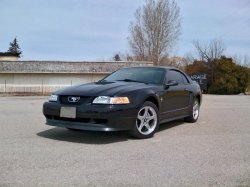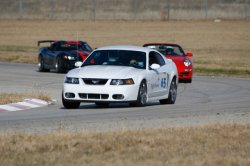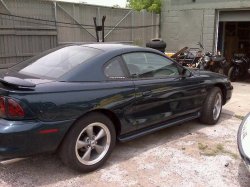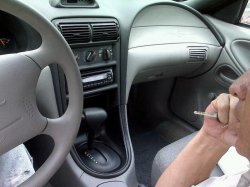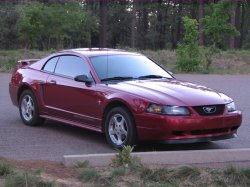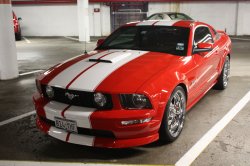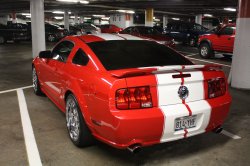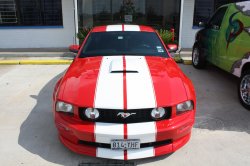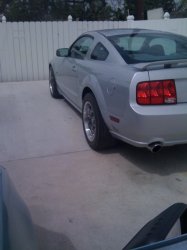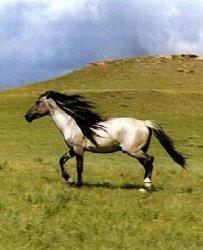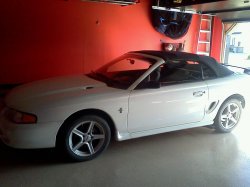Got a tip for us?
Let us know
Become a MacRumors Supporter for $50/year with no ads, ability to filter front page stories, and private forums.
Post a pic of your Mustang!
- Thread starter TheVidEditor
- Start date
- Sort by reaction score
You are using an out of date browser. It may not display this or other websites correctly.
You should upgrade or use an alternative browser.
You should upgrade or use an alternative browser.
cool cars! My fav mustang era was 2005-2009. The new 2010 has a partial hoodscoop and is a little boxier. More like a camaro
Mine
My baby, 97 GT. it doesnt have any power stuff in it, but its fast and fun. and not bad for a 16th bday gift. still stock tho, prolly do a lil CAI and exhaust stuff to it. i wanna buy the rumored 5.0L v8 thats supposed to be out in 2011. but i love this car and could never get rid of it
My baby, 97 GT. it doesnt have any power stuff in it, but its fast and fun. and not bad for a 16th bday gift. still stock tho, prolly do a lil CAI and exhaust stuff to it. i wanna buy the rumored 5.0L v8 thats supposed to be out in 2011. but i love this car and could never get rid of it
Attachments
I thought you guys might enjoy some youtube videos of my friend's Cobra out on the track. Here's a montage video that captures the spirit of the track. That supercharger whine is insane. He's also got some less edited videos which are more interesting for the technicals and driving.
If any of you have ever considered taking your cars to the track I highly recommend it. You'll learn a lot and it's ridiculously fun.
If any of you have ever considered taking your cars to the track I highly recommend it. You'll learn a lot and it's ridiculously fun.
This is my '03 V6 Mustang. I have done a few engine mods...cold air intake, headers, off-road h-pipe, exhaust, computer tune. Interior has several stainless steel accents, white gage faces, Alpine stereo. Main reason I love the Mustang...can upgrade virtually anything in it. 
Attachments
As with all picture threads, I offer you a pleasant reminder to make our forum experience better for your fellow members by following these two guidelines:
1) Avoid quoting images -- please delete the image from the quotation. For instance:
[quote]This is mah cool stuff.
[SNIP][/quote]
2) If you inline large images, please use the TIMG tag instead of the IMG tag. The small image that is shown in the forum post can be clicked to see a full size. For instance:
[img]insertyourimageurlhere[/img]
Thank you!
1) Avoid quoting images -- please delete the image from the quotation. For instance:
[quote]This is mah cool stuff.
[SNIP][/quote]
2) If you inline large images, please use the TIMG tag instead of the IMG tag. The small image that is shown in the forum post can be clicked to see a full size. For instance:
[img]insertyourimageurlhere[/img]
Thank you!
Change the AWFUL wheels and you win.
Really?...i LOVE those wheels
i've posted 2 more pics here
https://forums.macrumors.com/threads/627003/
maybe MattZani change his opinion
https://forums.macrumors.com/threads/627003/
maybe MattZani change his opinion
hey
I have that same setup minus the front cooler , did you install it your self?


Heres my Vortech supercharged 99 GT. Pics taken with my 3GS of course.
I have that same setup minus the front cooler , did you install it your self?
This thread reminds me of Veggie Tales. Everybody's got a water buffalo...
http://www.youtube.com/watch?v=THCuvnWHoEs
Well where's my mustang!? Why don't I have a mustang...?
http://www.youtube.com/watch?v=THCuvnWHoEs
Well where's my mustang!? Why don't I have a mustang...?
You know ... sooner or later somebody is gonna start a flame war by inserting a camero in here and stating why its better, and another will post the new bumble-bee version. Its gonna happen, just be prepared, that's all.
Hey nobody posted any love for the 1990 model with the live rear axle, i loved how those hopped on tight corners even with suspension modified.
Hey no DECH or Saleen modified 80's or 90's models?!!
For you boys in the USA DECH was our equivalent of Saleen and bested Saleen on modifications until the mid 90's model arrived.


Hey nobody posted any love for the 1990 model with the live rear axle, i loved how those hopped on tight corners even with suspension modified.
Hey no DECH or Saleen modified 80's or 90's models?!!
For you boys in the USA DECH was our equivalent of Saleen and bested Saleen on modifications until the mid 90's model arrived.

HISTORY OF DECH MOTORSPORTS
DECH Motorsports was founded in 1985 by DEREK HANSON, seeking to provide an attainable high performance vehicle for racing enthusiasts, at an affordable price, the search was focused on the FORD MUSTANG and the CHEVEROLET CAMARO. The Mustang proved to be the victor, chosen for durability, weight and value, it would prove to be the ideal candidate for Derek's suspension tunning ability. Starting out with just a few dedicated customers, DECH set out to change the face of affordable high performance automobiles throughout Canada, and eventually all of North America.
Utilizing a vast knowledge of suspension, DECH set out to analyze all the performance parameters of the car, and evaluate which modifications would best elicit the desired level of handling neccassary to out perform everything else on the street, and the track. Designing and testing numerous types of coil springs ( using spring rate test equipment not just seat of the pants testing ) and combing the damping attributes of Koni struts and shocks, the net result was a car that could lap the track with ease and still comfortably convey their owners to and from the course, without shattering vertebrae. These early DECH Mustangs were custom built to owner specifications, and came with a base horsepower rating of 240 HP, many were destined for S.C.C.A. roadcourse events that DECH was soon to be dominant in.
Around this same time in the United States, a man named Steve Saleen was starting to put together his own SALEEN Mustangs, he had also recognized the potential of the FORD ponycar and with a background in scca racing he attacked the Mustang converting it into a world class super car. Although suspension, braking and aerodynamic modifications set the car apart from the rest of the pack, the car still lacked any significant power improvements. These were to be the cars directly compared to DECH Mustangs, and many would go head to head in competion. In fact DECH would provide Steve Saleen with a pit crew for his first race at Mosport Park in Toronto, ONT and DECH would use a modified version of the Saleen ground effects package on their first run of production cars for dealer distribution.
Soon afterward DECH decided to invest in designing, wind tunnel testing and producing their own aerodynamics system for all future production and customer vehicles, to further differentiate themselves from other aftermarket Mustang companies. The look alone would set the cars apart from the now very popular crowd, but what lay beneath the surface would elevate the car to cult stature in the circles of performance automobiles. Regularly whipping past exotics and other performance cars at open roadcourse events put on by DECH and other companies and car clubs. One ride around the course at Shannonville's Fabi track with Derek or his son, and cheif of research and development, Van Peter Hanson and all the potential of the cars become glowingly apartent. Continueous research and development through on track and on bench testing led the team at DECH to develope the SPEEDDRIVE Spring package, GRABBERS, Strut tower mount bearing assembly, Lower chassis stiffening member, and the DECH ASG rear suspension system , along with their own front disc braking system (unfortunately very expensive and soon outdated by the FORD Motorsport Cobra R m-2300-k package ) all proving their determination to produce the best possible machine and products without re-inventing the wheel.
The philosophy of the development team was " less is more ", by allowing the car to work as designed, they didn't need to rebalance the car for every small change applied to it (ie; no eurathane bushings on sway bars etc.. too tight in front means changes needed in rear to compensate and rebalance car) thus allowing the parts to be of highest quality since not every part on the car would be replaced and overall cost could be controlled. Typically the 1987-1993 DECH Mustang could be purchased for around $35,000 Canadian, very reasonable compared to vehicles of equal or lesser capabilities. Serviceable by any FORD dealer while being completely emissions legal, these performance machines became very popular on the SCCA circuit in CANADA and the United States.
Selling both complete cars, through their select dealers, and individual parts for customer improvement the team at DECH soon moved their sites to the new SN95 chassis of the 1994 redesigned Mustang. A briefing by FORD representatives showed all the improvements that would allow DECH to further refine the car into a totall thoroughbred. New capabiliteis built into the car allowed the fine tunning of the chassis to a new level while keeping the drivealilty exceptional. A new concept was utuilized in the design and production of a rear wing for the car, the AFD-IV would improve air flow aound the vehicle while improving traction at speed, by eliminating high speed lift. Complementing the wing was a new splitter style air dam, the AD-I would help hold the front tires to the road and deflect air towards the front brakes. Of course it looked great as well, a selling point all on it's own. The DECH ASG debued on the track with this car and would soon go into full production for the 1997 product year. Customers raved about the systems ability to control the rear axel, and the body weight transfer during braking, acceleration and cornering.
Power was also a important part of the development team's plan to elevate the car's status. The well known K&N air filter leads the list of modifications on all cars, DECH designed underdrive pullies, either a Walker Dynomax or Borla cat-back exhaust system, retooled stock exhaust headers, ported stock heads, 1.6 ratio roller rockers and modified intake track boosted power on the 5.0 Litre engine. The new 4.6 L cars soon got similar modifications with the SVO/Borla side exhaust kit being very popular. A supercharger from VORTECH would further enhance power producion for those so inclined. A complete list of specifications for the cars are available.
Register on MacRumors! This sidebar will go away, and you'll see fewer ads.


